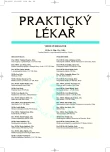An update on the Global strategy for asthma management and prevention – as viewed from the current situation in the Czech Republic
Authors:
V. Kašák
Authors‘ workplace:
LERYMED spol. s r. o.
; Oddělení respiračních nemocí, Praha
4
Published in:
Prakt. Lék. 2007; 87(4): 210-215
Category:
Reviews
Overview
The article reviews the Global strategy for asthma diagnosis, treatment and prevention as outlined in the GINA (Global Initiative for Asthma – under patronage of the WHO) publication of November 2006, as seen from the current asthma situation in the Czech Republic. The new publication contains fundamental changes in the approach to asthma treatment not noted in previous editions. The main aim of asthma treatment is achieve, and then maintain, clinical control. There are three levels of asthma control (controlled, partly controlled and uncontrolled asthma) and now five steps of asthma pharmacotherapy. Low dose inhaled glucocorticosteroids are the preferred initial controller treatment for patients of all ages with persistent asthma.
The first choice additional therapy is long-acting β2-agonists (LABA). But long-acting β2-agonists must only be used in combination with an appropriate dose of inhaled glucocorticosteroids. The use of the combination of a rapid-acting long-acting β2-agonist (formoterol) and an inhaled glucocorticosteroid (budesonide) in a single inhaler, both as a controller and reliever, is very effective and is a new concept in asthma therapy. Patients with asthma that do not reach an acceptable level of control at step 4 are considered to have difficult-to-treat asthma, characterised by a poor responsiveness to glucocorticosteroid treatment.
Key words:
asthma, pharmacotherapy, control of asthma, difficult-to-treat asthma.
Labels
General practitioner for children and adolescents General practitioner for adultsArticle was published in
General Practitioner

2007 Issue 4
Most read in this issue
- Todays trends of diagnostics and treatment of scaphoid bone fractures
- Extensive trombosis of thoracic aorta – an unusual source of acute peripheral arterial embolism.
- Epileptic fit as a syncope equivalent in severe aortic stenosis.
- Smoking and skin
